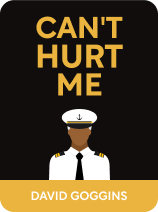

This article is an excerpt from the Shortform book guide to "Can't Hurt Me" by David Goggins. Shortform has the world's best summaries and analyses of books you should be reading.
Like this article? Sign up for a free trial here .
Do you want to know how to organize your time? How can David Goggins’ strategy for compartmentalizing help?
Ad one way for learning how to organize your time, David Goggins suggests compartmentalizing. This means dedicating different chunks of time solely to one tasks, and making sure those tasks stay separate.
Keep reading for advice on how to organize your time from David Goggins.
How to Organize Your Time According to David Goggins
People often think they need to have special talents to succeed in life. However, you often won’t be naturally talented at something. Instead, you need to schedule time every day to practice and hone your skills. This is the best way to learn how to organize your time.
For example, the number-one excuse people have for not exercising is that they don’t have enough time. But most people waste 4-5 hours a day doing things like watching shows or looking at social media. Doing this challenge will help you make time for working toward your goals.
Goggins’s life got extra busy once he started getting attention for his ultra racing. He learned to compartmentalize his time to work and train.
Becoming a Recruiter
After his success in Badwater 135, Goggins got recruited into doing a race known as the Ultraman—a three-day event consisting of a 6.2-mile swim, 261-mile bike ride, and a double marathon. Despite some difficulties with his bike—he blew out a tire on a downhill—he managed to finish second in the race.
Shortly thereafter, a Navy admiral contacted him. It’s uncommon for the upper leadership in the military to talk with enlisted people, so Goggins worried he’d be reprimanded for drawing undesired attention to the Navy by participating in ultras. In fact, the admiral was impressed with Goggins’s achievements and wanted him to recruit more black people into the Navy SEALS to work on operations against Taliban forces in northern Africa—they needed SEALS that would blend into the local population.
Goggins was only the 36th black person to become a SEAL in the Navy’s history, and the Navy realized it needed to do more outreach in communities of color. When he accepted the role, he learned a lot of important lessons about how to organize your time.
Balancing Recruitment With Life
To recruit more people of color, Goggins traveled to colleges and high schools across the country to speak.
He learned that using himself as a prop was one of the most effective strategies to get students interested in his message. He’d run 50 miles to his speaking engagement and show up sweaty, or spend the first five minutes of his speech doing push-ups. He’d practice with the sports teams and invite students to work out with him before or after school and crew for him on weekends when he competed in local ultra races. He’d also run between cities he was visiting to garner local news coverage.
He recognized that most people wouldn’t be interested in becoming a SEAL, so he worked to appeal to a broader swath of people, encouraging them to live to their fullest potential.
During his busiest period as a recruiter, he was on the road for 250 days per year, but he still made time for physical training and competing in races on top of logging 50 hours at work each week. For part of 2007, he ran an ultra race nearly every weekend, giving a great answer to the question “how to organize your time?”
To achieve this, Goggins developed strategies to squeeze in exercise around his work schedule. For example, when he wasn’t traveling, he’d wake up early and run for 6-10 miles before work, then bike 25 miles to work, run or hit the gym during his lunch hour, and bike home.
On weekends he didn’t have an ultra event, he’d do a three-hour workout on Saturday, then spend the rest of the day with his wife. Sundays were his rest day—he did only very light exercise to promote good circulation.
Take Action: How to Organize Your Time With Compartmentalization
If you still want to know how to organize your time, take this challenge over 3 weeks. Here are the steps:
- In the first week, make detailed notes about how you spend each 15-30 minute chunk of your day. Note things like how much time you spend on your lunch break, how long your commute is, and whether you’re working without interruption or trying to multitask. Notice when you spend time that could be put toward working on your goals instead.
- For the second week, schedule out your time. Decide what you’re going to do with each fifteen- to thirty-minute chunk of time in your day. This includes exercise and rest. Some activities will require multiple chunks of time. Just make sure you’re not trying to squeeze multiple tasks into the same chunk—focus on one activity at a time. Continue taking notes about how you spend your time.
- For the third week, refine your schedule further based on your experience in the first two weeks. Ideally, you shouldn’t need to lose sleep but should have arrived at a schedule that provides the maximum amount of time to do your important activities.
- (Optional) Share your schedule on social media with the hashtags #talentnotrequired and #canthurtme.

———End of Preview———
Like what you just read? Read the rest of the world's best book summary and analysis of David Goggins's "Can't Hurt Me" at Shortform .
Here's what you'll find in our full Can't Hurt Me summary :
- What a Navy SEAL says about pushing yourself to achieve greatness
- How to put in more effort to realize your potential
- The 10 challenges you can take on to reach your goals






